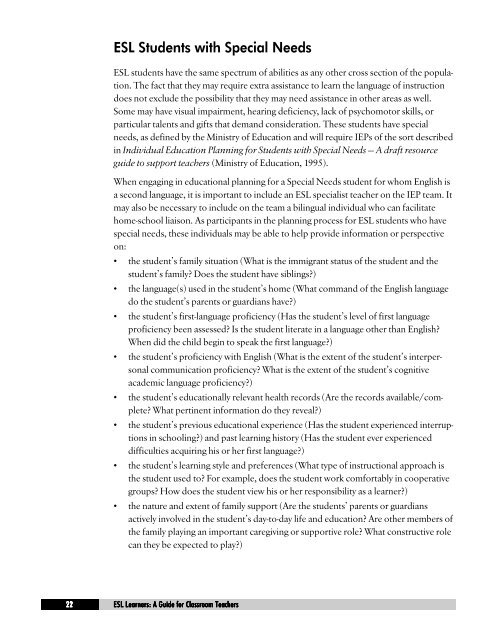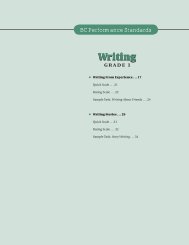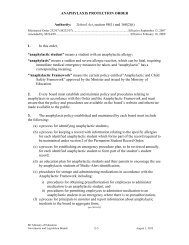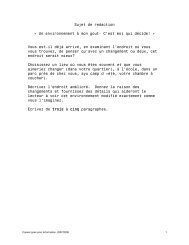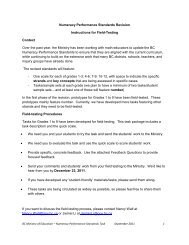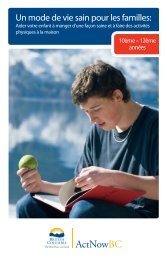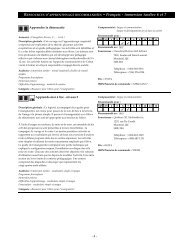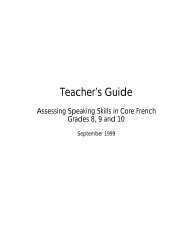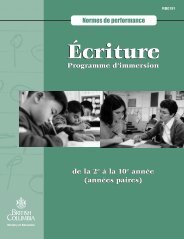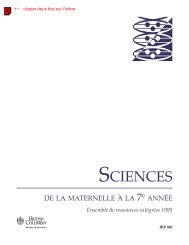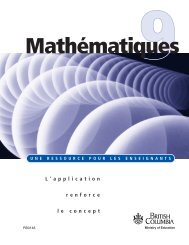A Guide for Classroom Teachers - Education
A Guide for Classroom Teachers - Education
A Guide for Classroom Teachers - Education
Create successful ePaper yourself
Turn your PDF publications into a flip-book with our unique Google optimized e-Paper software.
22<br />
22<br />
ESL Students with Special Needs<br />
ESL students have the same spectrum of abilities as any other cross section of the population.<br />
The fact that they may require extra assistance to learn the language of instruction<br />
does not exclude the possibility that they may need assistance in other areas as well.<br />
Some may have visual impairment, hearing deficiency, lack of psychomotor skills, or<br />
particular talents and gifts that demand consideration. These students have special<br />
needs, as defined by the Ministry of <strong>Education</strong> and will require IEPs of the sort described<br />
in Individual <strong>Education</strong> Planning <strong>for</strong> Students with Special Needs — A draft resource<br />
guide to support teachers (Ministry of <strong>Education</strong>, 1995).<br />
When engaging in educational planning <strong>for</strong> a Special Needs student <strong>for</strong> whom English is<br />
a second language, it is important to include an ESL specialist teacher on the IEP team. It<br />
may also be necessary to include on the team a bilingual individual who can facilitate<br />
home-school liaison. As participants in the planning process <strong>for</strong> ESL students who have<br />
special needs, these individuals may be able to help provide in<strong>for</strong>mation or perspective<br />
on:<br />
• the student’s family situation (What is the immigrant status of the student and the<br />
student’s family? Does the student have siblings?)<br />
• the language(s) used in the student’s home (What command of the English language<br />
do the student’s parents or guardians have?)<br />
• the student’s first-language proficiency (Has the student’s level of first language<br />
proficiency been assessed? Is the student literate in a language other than English?<br />
When did the child begin to speak the first language?)<br />
• the student’s proficiency with English (What is the extent of the student’s interpersonal<br />
communication proficiency? What is the extent of the student’s cognitive<br />
academic language proficiency?)<br />
• the student’s educationally relevant health records (Are the records available/complete?<br />
What pertinent in<strong>for</strong>mation do they reveal?)<br />
• the student’s previous educational experience (Has the student experienced interruptions<br />
in schooling?) and past learning history (Has the student ever experienced<br />
difficulties acquiring his or her first language?)<br />
• the student’s learning style and preferences (What type of instructional approach is<br />
the student used to? For example, does the student work com<strong>for</strong>tably in cooperative<br />
groups? How does the student view his or her responsibility as a learner?)<br />
• the nature and extent of family support (Are the students’ parents or guardians<br />
actively involved in the student’s day-to-day life and education? Are other members of<br />
the family playing an important caregiving or supportive role? What constructive role<br />
can they be expected to play?)<br />
ESL ESL Learners: Learners: A A <strong>Guide</strong> <strong>Guide</strong> <strong>for</strong> <strong>for</strong> <strong>Classroom</strong> <strong>Classroom</strong> <strong>Teachers</strong><br />
<strong>Teachers</strong>


